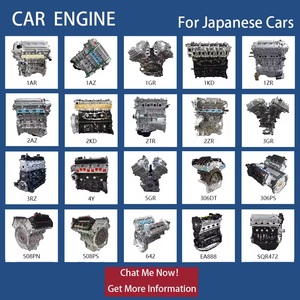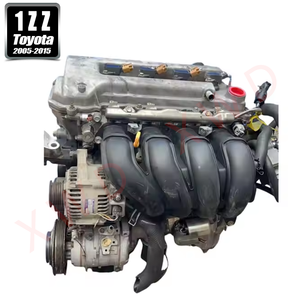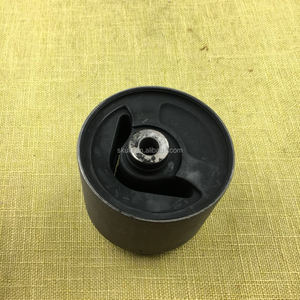(693 products available)




















































































































































































































The engine 1mz is a 3.0L V6 internal combustion engine. It was used in a variety of Toyota and Lexus vehicles from 1994 to 2007. The 1MZ engine family consists of four members. They are the 1MZ-FE, 1MZ-FE2, 1MZ-FE E85, and 1MZ-GE.
1MZ-FE:
This was the first engine in the 1MZ family. It had aluminum alloy cylinder heads with 4 valves per cylinder. The 1MZ-FE used a cast iron block. Each cylinder had a bore and stroke of 83 mm x 78 mm. The compression ratio was 10.0:1. The engine had a Dual Overhead Camshaft (DOHC). The 1MZ-FE used a Sequential Multiport Fuel Injection (SMPI) system. The engine was rated between 190-220 hp, and 204- 300 lb-ft of torque. The 1MZ-FE engine was used in a variety of front and rear-wheel drive layouts.
1MZ-FE2:
This is a less common variant of the 1MZ engine. It is similar to the 1MZ-FE engine. However, the 1MZ-FE2 engine used a direct injection system. This allowed the engine to achieve better power and emissions.
1MZ-FE E85:
The 1MZ-FE E85 engine was designed to run on E85 fuel. E85 fuel contains 85% ethanol and 15% gasoline. This allowed the engine to produce more power and better fuel efficiency.
1MZ-GE:
This is a Toyota and Lexus gasoline engine. The 1MZ-GE was a more powerful and popular variant of the 1MZ engine. The 1MZ-GE engine was widely used in most Lexus vehicles.
Regular oil changes
Replace engine oil every 3000-5000 miles (or as per the owner's manual) using the recommended oil type and filter. This lubricates parts and prevents sludge buildup.
Air filter replacement
Check the air filter every 10,000 miles and replace it if dirty. A clean filter ensures good airflow to the engine, optimizing performance and fuel efficiency.
Spark plug inspection
Inspect spark plugs at 30,000 miles for wear or deposits. Reseat loose plugs and replace others per the schedule. Well-functioning plugs ensure complete combustion, improving power and mileage.
Tune-ups
Follow the manufacturer's tune-up schedule (usually 30,000-60,000 miles). Technicians check ignition timing, valve clearances, emissions, etc. They ensure all engine systems run at peak efficiency.
Cooling system service
Flush and refill coolant every 60,000 miles (or 5 years). This prevents overheating by removing old fluid and contaminants. Also, check hoses and the radiator for leaks or damage.
Fuel injector cleaning
Use a fuel system cleaner or have professionals clean injectors every 15,000 miles. Dirty injectors can cause uneven fuel spray, hurting mileage and acceleration.
Throttle body inspection
Inspect the throttle body at 60,000 miles. Build-up of carbon can restrict airflow. A simple cleaning maintains smooth acceleration and engine response.
Chassis lubrication
Lubricate suspension joints, door hinges, etc., every 5000 miles (or as needed). This keeps moving parts working well, avoiding squeaks and premature wear.
Monitoring engine codes
Use a scanner to check for engine trouble codes anytime the "check engine" light comes on. The codes point to problems that should be fixed right away before they get worse.
Regular driving
Avoid too much stop-and-go driving or short trips where the engine doesn't fully warm up. Take longer routes sometimes to help the engine and emissions systems operate properly.
Now that we know what the 1MZ engine is, how do we choose the right one?
Replacing the 1MZ engine is a complicated task that requires professional skills. However, it can also be a DIY project with the right tools, knowledge, and skills. Here are the steps to follow when replacing the 1MZ engine as a DIY project:
Gather the right tools
With the right tools, working on the 1MZ engine and even replacing it will be a simple task. Users will need tools like sockets, wrenches, a jack and jack stands, an engine hoist, a torque wrench, and basic hand tools. Also, have an OBD2 scanner to help read error codes and help troubleshoot. Make sure the garage is well lit to see all the engine parts clearly. Wear safety gear like gloves and safety glasses to protect from sharp metal parts.
Prepare the vehicle
To prepare the vehicle, disconnect the car battery to ensure safety during the replacement. Then raise the vehicle using a jack and jack stands to create space for working under the vehicle. After that, pop open the hood and remove the engine cover to give access to the engine.
Drain fluids
Drain all fluids from the engine, including the engine oil and coolant. Use a pan under the engine to catch all the fluids as they leak. This process protects the user and the environment from harmful chemicals found in engine fluids. Also, wait for the engine to cool down before draining the fluids.
Disconnect the engine
Start disconnecting all cables and hoses connected to the engine. This includes electrical connections like the spark plug wires, air intake connections, and coolant hoses. Also, disconnect the fuel lines from the engine. Make sure to follow the safety procedures when disconnecting the fuel lines. Then, disconnect the transmission from the engine by removing the bolts holding it in place.
Remove the engine
Once the engine is disconnected from the vehicle, use the engine hoist to carefully lift it out of the engine bay. Follow all safety procedures when removing the engine to prevent accidents and injuries.
Install the new engine
To install the new engine, place the new engine on the engine hoist and lower it carefully into the engine bay. Then, make sure the engine is aligned with the mounts on the vehicle. After that, reconnect the engine to the transmission by installing it to the engine using the bolts. Then, reconnect all the electrical connections, cables, and hoses that were disconnected in the previous steps.
Fluids and final checks
After installing the new engine, refill it with new engine oil and coolant. Then, start the engine and let it run for a few minutes. This helps users check if there are any leaks and ensure the replacement process was successful. Finally, double-check to make sure everything is in place and the engine is running smoothly.
Q1: Which cars have the 1MZ-FE engine?
A1: The 1MZ-FE engine was used in many vehicles from the Toyota and Lexus brands. These include the Toyota Camry, Toyota Avalon, Toyota Highlander, Toyota RAV4, and Taina. The 1MZ-FE engine was also used in the Lexus ES 300 and Lexus RX 300. The engine was used in most of these vehicles until they stopped production or changed the engine.
Q2: What is the difference between 1MZ-FE and other 1MZ engines?
A2: The 1MZ-FE and other 1MZ engines have the same basic specifications. They are all V6 petrol engines with a 60-degree angle between the cylinders. The differences are in the details. For example, the 1MZ-FE engine has an aluminum alloy cylinder block with a bore of 87.5 mm and a stroke of 83 mm. The compression ratio is 10.5:1. The 1MZ-FE engine also has an electronic ignition system and a cooling system with a thermostat.
Q3: What are the common problems and solutions with the 1MZ-FE engine?
A3: The 1MZ-FE engine has a few problems. However, they are not serious and can be fixed easily. One of the problems is overheating. This can be caused by a faulty water pump, thermostat, or radiator. Another problem is engine vibration. This can be caused by worn-out spark plugs, ignition coils, or engine mounts. There are also oil leaks from the valve cover gaskets or oil sump. The gaskets need to be replaced to stop the oil leaks.
Q4: What is the meaning of 1MZ?
A4: The ""1"" in 1MZ denotes the number of cylinders in the engine. The ""M"" is a code used by the manufacturers to show that the engine is part of the M family. The Z denotes the engine design.
The web search volume for the keyword "engine 1mz" has shown a stable interest over the past year with an average monthly search count of 1000. Despite a zero percent change in the last three months, there has been a notable 14% increase in web search volume over the past twelve months.
Analyzing the detailed monthly data, we notice that web search volumes fluctuated between 880 and 1000. Specifically, volumes dipped to 880 during the months of May, June, and July, before rebounding back to 1000 in the subsequent months. This pattern suggests a seasonal variation, with higher interest in the engine 1mz during the later months of the year.
The consistent web search volume in the months following the dip indicates that the engine 1mz maintains a steady interest among vehicle parts and accessories enthusiasts. This could be attributed to ongoing relevance in automotive repairs and modifications, highlighting a niche but persistent demand in the market.